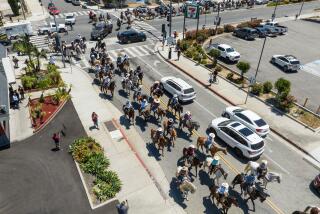Kids, Cowboys Star at Simi Days Rodeo
- Share via
Save for the snorts of angry bulls and the whoops of rodeo lovers, the annual Simi Valley Days carnival ended Sunday a bit more quietly than it has in the past.
Attendance was down slightly from previous years, organizers said, estimating that 20,000 people ambled through the dusty gates between Wednesday and Sunday night. Last year’s event drew more than 23,000 people.
Higher gate prices made some fans kick, but they were actually getting a bargain, said Mary Ann Fiore, gate chairwoman of the Simi Valley Days committee.
This year, the rodeo and rodeo dance were free to anyone who paid the $5 entrance fee, while past rodeo fans paid $3 at the gate plus $7.50 for the dance and up to $12 for the rodeo, she said.
This was also the first time the Simi Valley Days committee ran the rodeo, which was previously managed by the Elks Club.
Costs for the five-day carnival, including rides, contests and a parade, along with the rodeos Saturday and Sunday, have come to about $100,000, said committee chairman Wes Miller. The gate prices and the new stewardship of the rodeo may take a little getting used to, he said.
“It’s breaking new ground,” Miller said of the committee’s role.
And although the crowds may have been smaller overall, they have been steady, said Shari Schultz, the committee’s promotions chairwoman. Attendance was strong for special events such as Wrist Band Night on Wednesday, when $6 would buy a night’s worth of rides. And the Rodeo Dance on Saturday packed the floor, she said.
This year’s parade also had the most participants ever, with 3,600 people marching or riding floats.
While the organizers tallied and figured, cowboys and cowkids twisted and jerked atop reluctant mounts in the rodeo ring.
Wearing helmets and grim faces, would-be cowpokes ages 4 to 7 tried their might at “mutton-busting,” clambering onto the backs of runaway sheep and holding on for dear life.
Young Holly Hall clamped both knees around her sheep’s middle and dug her fingers into its fleece as it galloped through the ring. She slipped down its flank and clung to its side before hitting the dirt, then gamely brushed herself off and traded high fives with a clown.
Then came hard-core, hyphenated rodeo sports--bull-riding, steer-wrestling, bronco-busting and calf-roping--and cowboys who drove far to compete for $500 purses.
One by one, riders lashed themselves to 500-pound bulls and burst from the gate, thrashing around the ring until they were thrown. One by one, steers bolted out of a blue steel cattle chute, horsemen charging behind.
Danny Green of Valley Springs raced after his target and leaped on its neck, his boot heels gouging the dirt. He twisted the steer’s left horn to its right shoulder, pulled up on its chin and wrenched it onto its back in less than five seconds.
Outside, two dozen members of Animal Emancipation Inc. decried what they called needless cruelty, pointing to the flank straps that are cinched around bulls’ and broncos’ groins to make them buck.
“They are born and bred to buck,” said rodeo operator Alan Miller of Flying U Rodeos. “We’re not hurting them. It’s a sport that’s been going on for years.”
“It’s classy lookin’ and it’s fun, it’s very stylish and graceful,” said Justin Denton of Murrietta, who has broken his collarbone, arm, rib and ankle riding.
Flying from the gate, keeping your timing and riding eight long seconds to the whistle, said Denton, “is a really sweet thing.”
More to Read
Sign up for Essential California
The most important California stories and recommendations in your inbox every morning.
You may occasionally receive promotional content from the Los Angeles Times.













